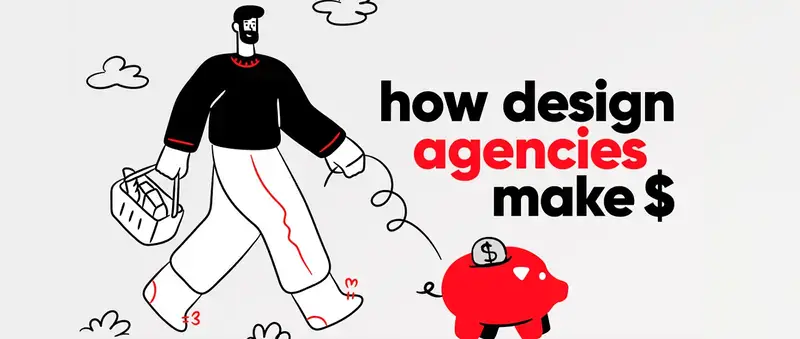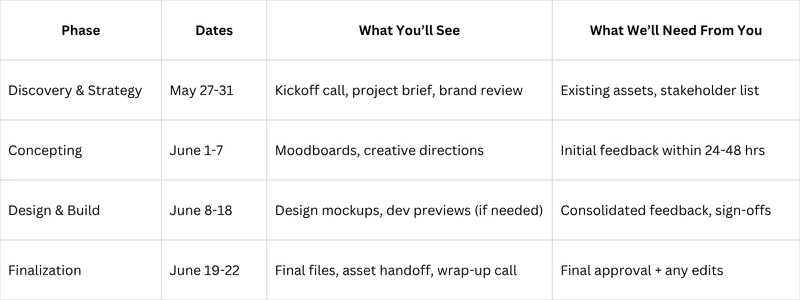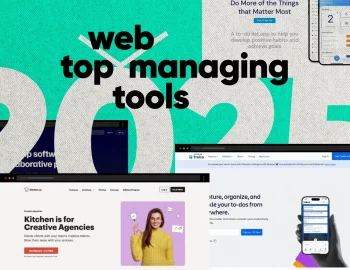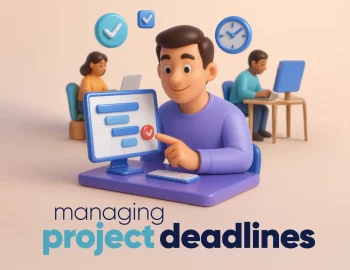Every creative agency has been there: a client expecting final designs yesterday, feedback that arrives a week late (and totally contradicts itself), or a “quick” extra request that somehow derails the entire timeline. It’s rarely intentional – more often, this misalignment is just a sign that no one ever really explained how to manage client expectations from the start.
That’s why, for business owners and project managers, managing client expectations effectively isn’t just part of the job – it’s the glue that holds timelines, budgets, and team morale together. When expectations are clear and shared from the start, projects flow more smoothly, creative work gets the space it needs, and client relationships deepen over time.
And in this article, you will find your toolkit for setting realistic goals and managing client expectations that actually work, helping you guide clients with clarity from day one. Let’s begin now, shall we?
1. Start strong: Set expectations early and often
The earlier you set the tone, the smoother everything runs. Seriously, so many client headaches come from assumptions made before the project even kicks off. That’s why setting client expectations isn’t just a one-time chat – it’s something you weave into every stage and manage constantly, starting from that very first call.
Think of onboarding like setting up a campsite. You want everything laid out clearly – where things go, what’s included, and what happens if a bear (aka last-minute request) shows up. That means walking the client through what’s going to happen, when it’ll happen, and what’s expected of them, too.
A few things to cover upfront:
- Project scope: what’s included and what’s not (with examples if possible)
- Timelines: major milestones and review dates
- Feedback process: how many rounds, who gives feedback, and in what format
- Communication: when and how you’ll check in
- What causes delays, for example, missed feedback deadlines or late asset delivery
The trick is to be clear and human. This isn’t about scaring them with legal jargon – it’s about showing them, “Hey, here’s how we work best, and here’s how we’ll make this awesome together.”
Expectation-Setting Email Template (Pre-Kickoff)
Subject: Here’s What to Expect Before We Get Rolling
Hi [Client Name],
I’m excited to kick things off! Before we dive in, I wanted to share a quick overview of how we’ll work together so everyone’s on the same page:
- Project scope: [Quick summary]
- Timeline: [Key dates + milestones]
- Feedback: [# of rounds + who gives it]
- Communication: [Preferred method + rhythm]
These basics help everything run smoothly, and of course, I’m here if anything ever feels unclear.
Looking forward to getting started!
Cheers,
[Your Name]
Want to take it one step further? Build a simple onboarding checklist that includes what the client owes you (brand assets, team contacts, access credentials, etc.) and share it alongside the welcome email. It instantly positions you as organized, proactive, and in control, which, let’s be honest, is exactly the vibe your team needs heading into any creative project.
2. Talk about the process like a pro
If there’s one thing new clients love, it’s clarity. And if there’s one thing they don’t always grasp, that’s how much time, thought, and iteration go into creative work. That’s why, if you want satisfied clients, it’s essential to walk them through your process and practice proactive communication.
Start by breaking down the major phases of your work. Whether it’s strategy → creative concepting → design → refinement → delivery, the goal is to show how each step builds on the last. Explain what’s happening behind the scenes during those “quiet” days so they don’t mistake thoughtful work for radio silence.
A few friendly ways to frame things for clearer client expectations:
- “Before we start designing, we’ll be doing a deep dive into your brand goals and audience. This gives the creative work way more focus and impact.”
- “Our process includes time for exploration, review, and refinement – it’s designed to prevent rushed work and last-minute fire drills.”
- “Here’s what each week looks like on the timeline, so you’ll always know where we are and what’s coming up.”
And don’t underestimate the power of a good visual. A simple project timeline or phase diagram helps clients see the pacing and gives them confidence that everything’s moving with purpose.
Milestone Timeline Example (Client-Friendly View)
You don’t have to over-explain – but when clients understand what’s happening and why it matters, they’re far more likely to trust the process and respect your team’s time.
3. Say No (without saying “No”)
Here, you’ve got to understand – you can’t avoid scope creep – clients don’t always mean to push boundaries, but it will happen. A tiny “Can we just add…” here, a surprise change there, and suddenly your perfectly scoped project is looking like a creative buffet. That’s where the magic of the graceful no comes in. It’s all about protecting the team’s focus without putting the client relationship at risk.
To be good at managing the expectations of clients means knowing how to say “No”, but…Instead of flat-out “no,” think of it as redirecting the request. Offer options, communicate openly, explain the tradeoffs, or fold it into a future phase – just don’t absorb it into the current timeline and hope for the best (your team will notice, and not in a good way).
Scope Creep Response Toolkit
Keep a few tools handy:
- A running “Nice-to-Have” list you can reference later
- A change request form or doc (even informal) that outlines time/cost impacts
- A clearly stated revision limit in your original agreement
Also, make your approval rounds feel official. If a design gets approved in Round 2, but feedback keeps rolling in during Round 4… kindly point back to the process:
“Since we’re already past the two included revision rounds, we’ll need to treat any new changes as an enhancement. Want me to estimate the impact and circle back?”
It keeps things professional and shows the client you’re being thoughtful, not inflexible. Boundaries feel a lot more like collaboration when you wrap them in clarity and kindness. And if you need a deeper dive into the topic, check out here – How to Tell a Client “This Is Out of Scope” Without Burning Bridges.

4. Align sales promises with production reality
To avoid potential setbacks and protect timelines (and your team’s sanity), you need a strong handoff between whoever’s pitching and whoever’s delivering. That doesn’t mean killing the vibe – it just means giving reality a seat at the table before the project starts.
Here’s how to set realistic goals and bridge the gap:
- Bring Project Managers into the pitch process early. Even if it’s just to sanity-check scope or timeline assumptions, this tiny step can prevent huge headaches later.
- Standardize your scopes. Create a few repeatable service packages that make it easier to set realistic expectations.
- Use a shared discovery doc. When sales and production collaborate on a single intake form, you reduce guesswork and capture what really matters for achieving success (not just what sounded good on the phone call).
- Confirm the deliverables scope in writing. Not just “what we’re doing,” but also “what we’re not.”
Pro Tip: Always remember that it’s better to under-promise and over-deliver than the other way around.
Translate sales speak into production speak
PM asks: “Does that include logo variations, a typography system, brand guidelines, social templates… or just creating the logo?”
Sales says: “We’ll build a custom site.”
PM asks: “Custom design and custom development? CMS integration? Animations? What platform are we talking about?”
The goal isn’t to limit the vision – it’s to define the deliverables so the team isn’t left guessing (or rushing). And hey, this kind of alignment means managing expectations the right way, and this doesn’t just prevent potential conflicts with clients. It builds trust between all parties involved, and your clients will quickly see that your agency doesn’t overpromise. It delivers success.
5. Create a clear feedback loop (and avoid revision chaos)
Nothing derails a project faster than vague, late, or scattered client feedback and communication. That’s why setting up a clear feedback loop from the start is non-negotiable. The goal isn’t to limit input – it’s to channel it in a way that’s actually helpful for the team and keeps things moving towards successful execution.
Start with three key questions:
- Who gives feedback? (Identify one point person or a small group – not the whole company.)
- When is it due? (Set firm review windows and include them in your project timeline.)
- How should it be delivered? (Centralized, clear, and ideally in writing.)
Once that’s nailed down, give clients a simple framework for how to give useful feedback:
- Focus on the goal: What’s working? What’s missing?
- Be specific: “The tone here feels too formal” is gold. “I don’t like it” is a dead end.
- Keep revisions consolidated: Group all feedback into one document or platform.
Feedback Guidelines You Can Steal
As we head into review, here’s how to make the most of your feedback round:
– Please consolidate comments from your team before sending them back.
– Be specific about what’s not working and why.
– Avoid design by committee – assign one key person to make the final call if there are conflicting opinions.
– Use [tool name or doc link] to leave feedback directly.
We’ve included [#] rounds of revisions in the project scope, so this phase is all about refining, not reinventing.
Thanks so much – we can’t wait to dial things in!
By making the feedback process easy and structured, you help clients feel heard without opening the door to endless revisions and potential delays. Everybody wins.
6. Use boundaries to build trust
Boundaries often get a bad rap – like they’re something you set when things go wrong. But here’s the truth: boundaries are one of the most professional tools to build trust with clients and manage their expectations that you’ve got. When communicated right, they’re not harsh… they’re helpful. They show clients there’s a plan, a managed process, and a team that values their time and its own.
Think of it like this: transparent communication upfront prevents reactive explaining later. You don’t want to wait until your team’s exhausted to say, “Hey, we can’t take that on.” Sometimes you can’t avoid difficult clients. Instead, you build those limitations right into your workflow from the start, so everyone knows what’s normal, what’s extra, and when to pause and reassess.
Here’s how to do it:
- Set expectations around response time (yours and theirs).
- Reinforce revision rounds and turnaround windows early, and repeat them when needed.
- Use your timeline as a boundary tool: when a client misses a feedback window, be ready to adjust downstream dates accordingly.
When to Step in and Hold the Line
- A client sends feedback after the revision deadline – again.
- Client asks for a “quick tweak” that changes the scope (hello, new features or extra formats).
- The team’s stuck in back-to-back edits with no clarity on final sign-off.
“I want to make sure we’re giving this the focus it deserves. Since this request goes beyond the original scope, let’s take a moment to realign the timeline and next steps. I’m happy to send over an updated estimate so we can keep things moving smoothly.”
“We’ve hit the final revision round included in the scope – if you have more changes, we can absolutely accommodate them as an additional phase. Want me to get that scoped out for you?”
These aren’t confrontational – they’re calm, confident nudges that remind clients you’re here to deliver great work without burning out the team behind it.
7. Normalize check-ins and realignment moments
Here’s a little secret: managing client expectations isn’t a one-time thing. It’s not just a solid kickoff doc or a well-worded email. It needs a proactive approach and regular communication throughout the project, because even the clearest plan can drift off-course if no one’s steering.
That’s why regular updates aren’t just polite – they’re strategic. They give you space to reinforce what’s working, correct what’s not, and re-sync on what to expect next. And when they’re baked into your process from the start, they feel like a natural part of collaboration… not a red flag.
Here are a few ways to build realignment into your flow:
- Monthly status reports: A light-touch email or doc that outlines progress, what’s been completed, what’s coming next, and any concerns.
- Midpoint review calls: Perfect for longer projects – use this time to check goals, timelines, and scope alignment.
- “Temperature check” moments: Quick, informal asks like: “How’s everything feeling on your end?” or “Still aligned on priorities?” These small questions surface big insights.
And if something has drifted? That’s okay. A well-structured realignment conversation can bring everything back on track before it turns into a crisis.
Mid-Project Review Agenda (Steal This)
Time Needed: 30-45 minutes
What we’ll cover:
- Recap of what’s been completed so far
- Review of outstanding deliverables + timeline check
- Any open questions or pending client input
- Feedback on process so far (What’s working? What’s not?)
- Scope or priority adjustments (if needed)
- Next steps + responsibilities
Bonus tip: Send a short summary after the call. It doesn’t need to be fancy – just clear. That follow-up becomes your shared “source of truth” moving forward.
Remember, these check-ins aren’t about micromanaging. They’re about mutual respect: you’re keeping the client informed, and you’re protecting the team from avoidable surprises.
Bottom line
At the end of the day, effectively managing client expectations isn’t about rigid rules or saying “no” all the time. It’s about setting the stage for trust, flow, success, long-term relationships, and truly great work where everyone gets to do their best, most creative work.
The tactics I shared aren’t one-size-fits-all. They’re flexible tools that business owners and project managers can borrow, adapt, and build into sustainable systems over time. And when client expectations are managed well? Your team thrives, your clients stay happy, and your projects don’t just finish – they shine.
Curious about how to manage your creative agency or practice good communication with clients more effectively? I’ve got the right articles for you:






